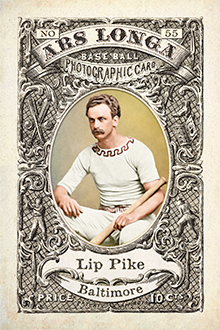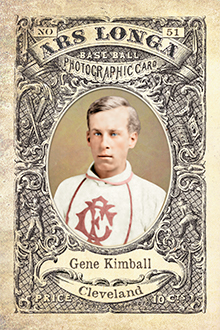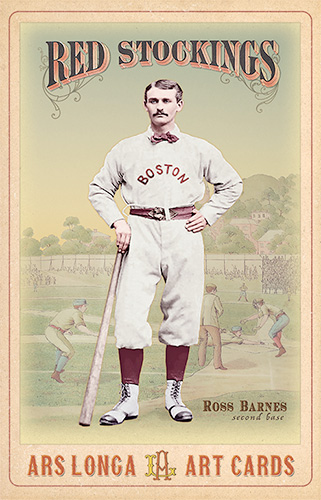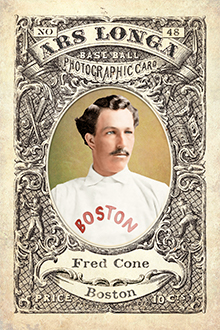
- Series: Pioneer Portraits I: 1850-1874
- City: Baltimore
- Team: Canaries
- League: National Association (NAPBBP)
Lipman Emanuel Pike (1845-1893) has many claims to fame as one of the most prodigious power hitters of early baseball. He was one of the first to be paid to play, he was a perennial field general on some of the best teams of his era, he hit some of the longest home runs in the earliest parks, he was one of the first players blacklisted, he was one of the fastest players of his time. And, if not the first, he was certainly the first Jewish player of note in the game. Pike came up in the infancy of baseball and starred for the great early clubs: The Brooklyn Atlantics, Philadelphia Athletics, NY Mutuals and the Irvington NJ nine. A solid all-around player, the southpaw even held his own at second and short. Movie-idol handsome, Lip always made his team look good. And he made a lot of teams look good. A lifelong itchy foot led Pike to change clubs as often as some players changed spikes. He never lasted more than two seasons with any franchise. In an era when home runs were scarce, Lip was one of the top sluggers. In 1883 Sporting Life documented a remarkable artifact of Pike's power. With the demolition of Brooklyn's old Union Grounds, the writer described the “pagoda” that had stood in right center from which rose an iron rod, bent from a ball struck by Pike and preserved as a cherished icon. Later research indicates Pike's HR slammed that rod 40 feet above the ground and about 360 feet from home plate hard enough to bend iron - in the deadball era.
- Pike, with eight others, was ousted by the NL owners in 1881 for suspicion of throwing games
- Out of the game, Pike returned to his family haberdashery in NY where he perished from heart disease at age 48. His renown persisted for decades, leading to one vote in the first HOF ballot in 1936

- Series: Pioneer Portraits I: 1850-1874
- City: Cleveland
- Team: Forest Citys (NAPBBP)
- League: National Association (NAPBBP)
Eugene Boynton Kimball (1850-1882) was an evanescent spirit on the early baseball scene. This ghost came to the (Cleveland) Forest Citys on May 4, 1871 and departed what was then major league play the following September. He had played in the early amateur National Association of Base Ball Players for the Alert of Rochester in 1869 and for the Cleveland club in 1870. That team was the first fully salaried team in Cleveland and was unaffiliated that season. In 1870 the Forest Citys (a designation adopted in recent years to distinguish the team from the pro club in Rockford, IL known as “Forest City”) were managed by Charlie Pabor. Charlie was dubbed “The Old Woman in the Red Cap,” giving him enduring status as the baseball figure with the most mysterious and alluring nickname of all time.
- Kimball’s debut in Rochester occurred on June 4, 1869 when the Alert hosted the powerhouse Cincinnati Red Stockings on their famed national tour. Gene played alongside other future major leaguers: John Glenn, Sam Jackson, John McKelvey and Ezra Sutton. The young amateurs held Harry Wright’s bombers to one of the closest margins of that undefeated season
- In his brief time with Cleveland, Gene managed a .191 average. He made 44 errors in 170 chances playing 2nd, 3rd, short and outfield in 29 games. It is reported that he achieved fair renown as a billiards player following his baseball career

- Series: Beginnings: 1870's
- City: Boston
- Team: Red Stockings (NAPBBP)
- League: National Association (NAPBBP)
Thomas Lamb Beals (1850-1915) played for four early major league teams, getting into 123 games in six seasons over the first decade of big league ball. He began in Washington D.C. with the Olympics of the NABBP in 1871. He batted .194 in 10 games, which was about a third of the schedule.. He came back the following year and hit .306 playing in all nine games. His manager with the Olympics was Nick Young, one of the founders of the game. He followed Young to the new D.C. club, the Blue Stockings, in ‘73. Beals was a regular that year and hit a respectable .276. He had played under the name W. Thomas in Washington. When he moved to the powerful Boston Red Stockings in 1874 he assumed his given name. He was only a part-timer in Boston for two seasons. When the National Association gave way to the new National League in ‘76 Tommy found himself out of work. He got one more chance with the White Stockings in 1880, getting into 13 games. His poor .152 average sent him into retirement.
- During his hiatus from the majors Beals had played briefly in the Bay Area for the SF Mutuals and the Oakland Pioneers in the California League

- Series: Beginnings: 1870's
- City: Boston
- Team: Red Stockings (NAPBBP)
- League: National Association (NAPBBP)
Charles Roscoe Barnes (1850-1915) was the best player in the five year history of the fist professional baseball league, the National Association of Professional Baseball Players (NAPBBP), 1871-1875. Barnes is the all-time NAPBBP leader in runs, hits, doubles, walks, stolen bases, total bases, batting average, OBP and SLG%. He then dominated the National League in its inaugural year, 1876, leading the league hits, runs, average, OBP, SLG%, total bases, doubles, triples and walks. He also hit the 1st HR in National League history, for the Chicago White Stockings, 5.2.1876. Over the first six years of his major league career, Barnes' batting average was .397. An unidentified illness limited Barnes to just 22 games in 1877, and he was never the same player again, retiring shortly thereafter at the age of 31.
“Roscoe C. Barnes…was the greatest second baseman the game ever had…” - A History of the Boston Baseball Club, 1897.
"No matter how great you were once upon a time — the years go by, and men forget. Ross Barnes, forty years ago, was as great as Cobb or Wagner ever dared to be. Had scores been kept then as now, he would have seemed incomparably marvelous.” - W.A. Phelan, Baseball Magazine, 1915
- Because he played in the second game in MLB history, is credited with the 17 other players that day as the 27th player to debut in MLB
- 1st hitter to win batting titles in 2 leagues: NA in ’72-73 and NL in ‘76
- In 1918, made Cap Anson’s all-time team as the shortstop
- Barnes was selected as SABR’s ”Overlooked 19th Century Baseball Legend “ for 2013

- Series: Pioneer Portraits I: 1850-1874
- City: Boston
- Team: Red Stockings (NAPBBP)
- League: National Association (NAPBBP)
Joseph Frederick Cone (1848-1909) played professionally for the Boston Red Stockings of the old National Association in 1871 and, at age 30, one season with the minor-league New Bedford/New Haven/Hartford club in the International Association. The Bostons were among the elite of their day with George and Harry Wright, and a young Al Spalding on the mound. In his latter stint, Fred played with many who would go on to major-league careers of note. Among them: Billy Barnie, Roger Connor, Jim Mutrie, and Harry Stovey. Such was the opportunity that lay before young ballplayers of that era. The game was rapidly establishing itself in the nation’s consciousness. History was being made and traditions were being formed.
- Cone batted .260 in his major-league campaign. In between his time in Boston and Connecticut, Fred was an umpire for two seasons: 1875 in the NA and 1877 in the NL
- Played amateur ball for the Rockford Forest Citys in 1868-69 before following teammates Spalding and Ross Barnes to Boston
- Rockford may have been the first to pay players, at least for their “practice” time




